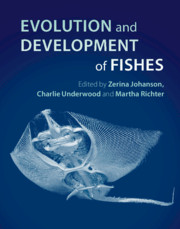Book contents
- Evolution and Development of Fishes
- Evolution and Development of Fishes
- Copyright page
- Contents
- Contributors
- Introduction
- 1 The Evolution of Fishes through Geological Time
- 2 Comparative Development of Cyclostomes
- 3 The Ordovician Enigma
- 4 The Evolution of Vertebrate Dermal Jaw Bones in the Light of Maxillate Placoderms
- 5 Doliodus and Pucapampellids
- 6 The Evolution of Endoskeletal Mineralisation in Chondrichthyan Fish
- 7 Plasticity and Variation of Skeletal Cells and Tissues and the Evolutionary Development of Actinopterygian Fishes
- 8 Origin, Development and Evolution of the Fish Skull
- 9 Evolution, Development and Regeneration of Fish Dentitions
- 10 Development of Head Muscles in Fishes and Notes on Phylogeny-Ontogeny Links
- 11 Evolutionary Development of the Postcranial and Appendicular Skeleton in Fishes
- 12 Evolution of Vertebrate Reproduction
- 13 Links between Thyroid Hormone Alterations and Developmental Changes in the Evolution of the Weberian Apparatus
- 14 Pharyngeal Remodelling in Vertebrate Evolution
- 15 Evolution of Air Breathing and Lung Distribution among Fossil Fishes
- Index
- References
10 - Development of Head Muscles in Fishes and Notes on Phylogeny-Ontogeny Links
A Basis for Evo-Devo and Developmental Research on Fish Muscles
Published online by Cambridge University Press: 31 December 2018
- Evolution and Development of Fishes
- Evolution and Development of Fishes
- Copyright page
- Contents
- Contributors
- Introduction
- 1 The Evolution of Fishes through Geological Time
- 2 Comparative Development of Cyclostomes
- 3 The Ordovician Enigma
- 4 The Evolution of Vertebrate Dermal Jaw Bones in the Light of Maxillate Placoderms
- 5 Doliodus and Pucapampellids
- 6 The Evolution of Endoskeletal Mineralisation in Chondrichthyan Fish
- 7 Plasticity and Variation of Skeletal Cells and Tissues and the Evolutionary Development of Actinopterygian Fishes
- 8 Origin, Development and Evolution of the Fish Skull
- 9 Evolution, Development and Regeneration of Fish Dentitions
- 10 Development of Head Muscles in Fishes and Notes on Phylogeny-Ontogeny Links
- 11 Evolutionary Development of the Postcranial and Appendicular Skeleton in Fishes
- 12 Evolution of Vertebrate Reproduction
- 13 Links between Thyroid Hormone Alterations and Developmental Changes in the Evolution of the Weberian Apparatus
- 14 Pharyngeal Remodelling in Vertebrate Evolution
- 15 Evolution of Air Breathing and Lung Distribution among Fossil Fishes
- Index
- References
Summary
The overwhelming majority of vertebrates are jawed gnathostomes. The success of this group is largely correlated with the evolution of the jaw and jaw muscles, as well as the evolution of head and neck muscles, that enabled the transition from filtration to active predation. The cephalic muscles comprise pharyngeal arch muscles, as the mandibular arch muscles that are associated with the jaw, hyoid arch muscles that are related to the hyoid apparatus, and more posterior branchial arch muscles, as well as hypobranchial and epibranchial muscles, which are somite-derived. The comparison of embryonic, larval, and adult morphology combined with studies of muscle development and genetic/molecular analyses enables us to reconstruct the evolutionary appearance of cephalic muscles throughout the main groups of vertebrates. Genetic/molecular studies revealed that there is a conserved gene regulatory network that guides the differentiation of head (pharyngeal arch mesoderm derived) and heart muscles (first and second heart field mesoderm derived) throughout vertebrates. Furthermore, the ontogenetic sequence of muscle development shows, in several vertebrates (e.g., teleosts, amphibians), a parallelism to the evolutionary sequence of muscle appearance, barring a few exceptions.
- Type
- Chapter
- Information
- Evolution and Development of Fishes , pp. 172 - 187Publisher: Cambridge University PressPrint publication year: 2019
References
Refercences
- 2
- Cited by

